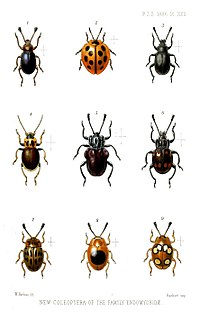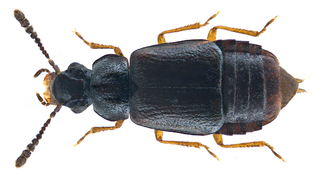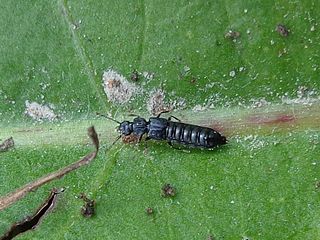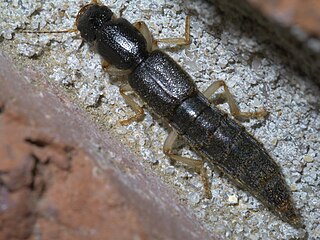
Fire-coloured beetles are the beetles of the Pyrochroidae family. Adults measure 4-20 mm; larvae reach 25 mm. Larvae of Pyrochroinae are found under moist bark of dead trees. They are probably mostly fungivorous, although they may become cannibalistic if too crowded.

Staphylinoidea is a superfamily of beetles. It is a very large and diverse group with worldwide distribution.

The family Pythidae is a small group of beetles with no vernacular common name, though recent authors have coined the name dead log bark beetles. There are about 10 genera and 17 described species in Pythidae.

Xyletininae is a subfamily of death-watch and spider beetles in the family Ptinidae. There are about 13 genera and at least 170 described species in Xyletininae.

Endomychidae, or handsome fungus beetles, is a family of beetles with representatives found in all biogeographic realms. There are around 120 genera and 1300 species. The family was established based on the type genus Endomychus, a genus erected in 1795 by Panzer which was applied to a species that Linnaeus called Chrysomela coccinea. As the common name suggests, Endomychidae feed on fungi. Crowson, in his influential treatment of the beetles, placed the family within the Cucujoidea. They have a tarsal formal of 4-4-4 or 3-3-3 and the wings lack a closed radial cell. The second antennal segment has a sensory appendage that is as long as the third antennal segment. The family has also been grouped with the Coccinellidae in a group called the Trimera for having pseudotrimerous tarsi. A 2015 molecular phylogeny study found that the Cucujoidea were found to be non-monophyletic and the Endomychidae was refined with the removal of the Anamorphinae from within the family and elevated to the status of a full family, Anamorphidae. Mycetaeinae and Eupsilobiinae were also found not to belong within the clades of the core Endomychidae, and likewise reclassified into the families Mycetaeidae and Eupsilobiidae.

The Oxytelinae are a subfamily of the Staphylinidae, rove beetles. There are about 20 genera and at least 320 described species in Oxytelinae.

Piestinae are a subfamily of Staphylinidae.

Melasinae is a subfamily of false click beetles in the family Eucnemidae. There are about 15 genera and at least 30 described species in Melasinae.

Homaeotarsus is a genus of rove beetles in the family Staphylinidae. There are about 16 described species in Homaeotarsus.

Anthophagini is a tribe of ocellate rove beetles in the family Staphylinidae. There are at least 20 genera and 20 described species in Anthophagini.

Dendrometrinae is a very large subfamily of click beetles in the family Elateridae, containing 10 tribes worldwide, including several formerly recognized subfamily-rank groups such as Athoinae, Crepidomeninae, Denticollinae, Oxynopterinae, Prosterninae, and Semiotinae now all reduced to tribal rank or lower.

Mycetoporini is a tribe of crab-like rove beetles in the family Staphylinidae. There are about 8 genera and at least 20 described species in Mycetoporini.

Omaliini is a tribe of ocellate rove beetles in the family Staphylinidae. There are about 12 genera and 19 described species in Omaliini.

Goniaceritae is a supertribe of ant-loving beetles in the family Staphylinidae. There are about 16 genera and at least 30 described species in Goniaceritae.

Attagenini is a tribe of carpet beetles in the family Dermestidae. There are at least 4 genera and 20 described species in Attagenini. Attagenini was previously considered a subfamily of Dermestidae called Attageninae, but was reduced in rank to tribe in 2003.

Ctenistini is a tribe of ant-loving beetles in the family Staphylinidae. There are at least four genera and about six described species in Ctenistini.

Oxytelini is a tribe of spiny-legged rove beetles in the family Staphylinidae. There are about 11 genera and at least 20 described species in Oxytelini.

Synchitini is a tribe of cylindrical bark beetles in the family Zopheridae. There are about 19 genera and at least 40 described species in Synchitini.

Pinophilini is a tribe of rove beetles in the family Staphylinidae.

Xyletinini is a tribe of death-watch and spider beetles in the family Ptinidae. There are at least 10 genera and 70 described species in Xyletinini.






















